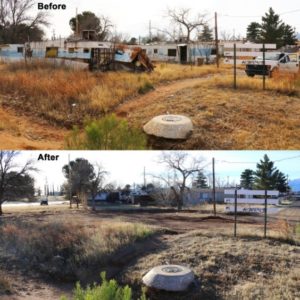Sierra Vista, Arizona
For many communities, annexation can be a complex and daunting undertaking. The case of Fry Townsite, however, is a reminder of the cost of inaction, including service vacuums for residents and unexpected challenges for neighboring municipalities.
The City of Sierra Vista was originally incorporated in 1956. As surrounding areas resisted annexation, county “islands” – areas surrounded entirely by incorporated city limits – began to emerge. These “islands” present a challenge for both the counties and surrounding cities in terms of service provision and the application or enforcement of municipal codes. Fragmented from central county services and absent a local government presence of its own, Fry Townsite —an island within Sierra Vista — had gradually deteriorated, becoming known for its high crime rates, dilapidated mobile homes, failing septic systems, excessive junk vehicles, and overall disrepair.
Since 2001 the City of Sierra Vista has worked in close partnership with its regional government, Cochise County, to address challenges within Fry Townsite, particularly those tied to crime and property conditions. The City agreed to remove graffiti in public areas within the area; a crime prevention task force between the two jurisdictions was developed; Community Development Block Grant (CDBG) funds from both entities were leveraged for drainage and road improvements; and code enforcement personnel cooperated to maximize impact to the neighborhood. Progress was made, but when revenues shrunk, so too did County resources and response to the island.
While the City had some success annexing portions of Fry Townsite in the past, a single obstacle was identified as not only preventing complete annexation, but also as being the source of many of the sites’ woes. An individual landowner had assembled multiple rental properties in Fry Townsite that were later determined to be among the most egregious. In addition, the County revealed that this individual had been severely delinquent in his property taxes. That information allowed the City and County to utilize a state law that would allow foreclosure on several tax delinquent properties. Working in partnership, the City Council authorized $90,000 to purchase the properties at auction and the County agreed to fund the cleanup up to $100,000.
Following the appropriate notification, the landowner filed for bankruptcy, effectively halting the project. But with some creativity and relationship building over the following year, city and county managers negotiated a settlement agreement that broadened the number of properties acquired and cleaned up; helped the landowner sell several more; ensured the ones he did keep were freed of tax and lien liability; and secured his commitment to annex his remaining properties in the future.
The final settlement agreement included and/or facilitated:
- Eleven properties deeded to the City, with the City assuming all tax/sewer liabilities, totaling $62,500
- Payment of additional back taxes on four properties totaling $33,400
- County waiver of a judgment lien of $85,000 on the largest property
- A six-month credit of $7,500 in refuse removal costs to encourage the landowner to clean up the 10 properties he continues to own
- Auction of the most egregious mobile home park (two parcels, with net proceeds of $18,000) with a requirement that the new owner cleans it off within 90 days, avoiding an estimated $75,000 expense
- Clean up of the eight remaining properties using public funds, $62,000
- Removal of any remaining junk vehicles owned by the landowner, $3,000
In total, 35 dilapidated or burned mobile homes and five failing structures were taken away, five failed septic tanks decommissioned, and dozens of junk cars, several tons of refuse, and numerous dead trees have been removed from the sites.
The local government management team of Sierra Vista and Cochise County took the lead in initiating, researching, and developing the idea, obtaining consensus from the elected bodies, and negotiating the final agreement. Mary Jacobs, Assistant City Manager was the primary contact with the landowner, and it was through the relationship building and authority she brought to the discussion that the agreement was brought to fruition. The resulting impact to the neighborhood instilled faith among the residents that the City and County care, and that their leaders are willing to challenge an irresponsible property owner for the benefit of the community.
Where most cities would reject annexation because of the cost to upgrade infrastructure and provide public safety services, the City of Sierra Vista desires to upgrade the level of services that the predominately low-income residents of this area receive. This project helped the community to grow its reliance on a professionally run government, as further evidenced by residents who are now requesting annexation. In addition, investors are beginning to look at the area for property purchase and redevelopment opportunities.
The forward momentum has led the City Council to direct staff to attempt annexation of all 250 remaining county island properties in this area in FY2018. The City Council has also recently provided authorization to allocate $15,000 of the City’s FY2018 CDBG funds for a program geared to provide financial assistance for blight removal of dilapidated homes and mobile homes. Property owners who participate in the program must commit to installing new housing units dedicated to serving families earning less than 80% of the median income.
Meet the Manager

